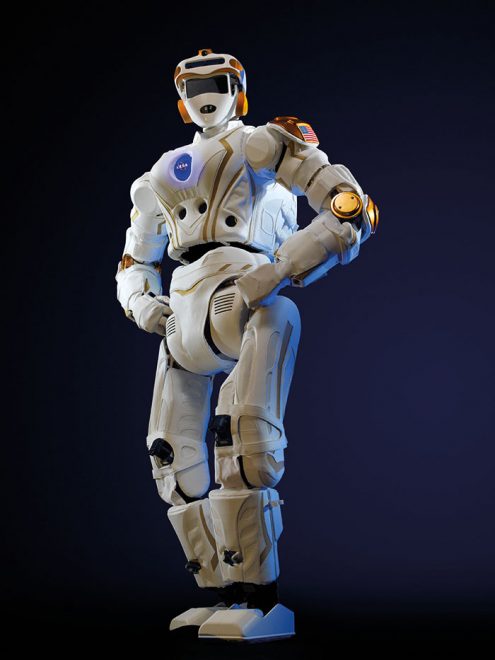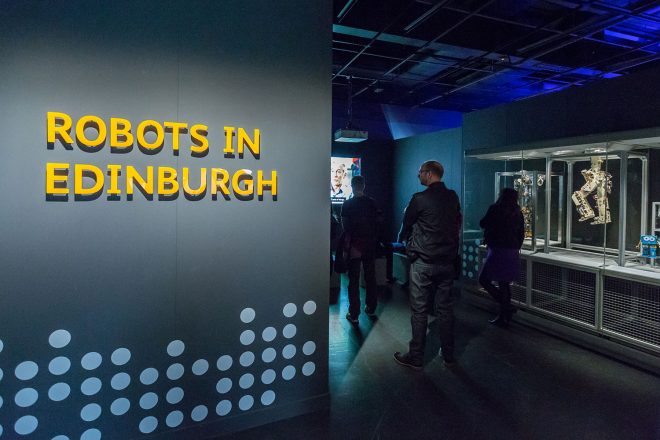Standing 1.8m tall, with white armour and a glowing blue NASA emblem on its chest, Valkyrie is the stuff of science fiction – the kind of benevolent android superhero you might see coming to the rescue of hapless humans in a post-apocalyptic world.

But this robot is very real indeed, and there is one right here in Edinburgh. Created by the Johnson Space Center (JSC) in 2015, the NASA R5, aka Valkyrie, is one of the most advanced humanoid robots in the world. It is designed to be robust, self-contained and capable of operating in the most inhospitable environments on Earth – or even, as is planned, on Mars.
In spring 2016, a NASA Valkyrie prototype took up residence on the southwestern fringe of the city at the Robotarium – the cutting-edge research facility of the Edinburgh Centre for Robotics (ECR), a joint venture between the University of Edinburgh and Heriot-Watt University. Here, researchers and PhD students are doing groundbreaking research in conjunction with JSC to further develop Valkyrie’s real-world capabilities and prepare it for deployment.
Says Sethu Vijayakumar, Director of ECR:
“Our Valkyrie is one of only three in the world. The other two are at Massachusetts Institute of Technology and the Institute for Human and Machine Cognition in Florida.
“Each centre has a slightly different emphasis: ours is on motion planning, real-time control and perception, developing the artificial intelligence Valkyrie needs to walk in cluttered spaces and carry out tasks. We are very fortunate to be working with this amazing hardware and co-developing its codebase, with the real possibility that it will be deployed on a future Mars mission.”
The fact that ECR is one of only three centres to be loaned this futuristic robonaut by NASA is testament to Edinburgh’s reputation as a world-class centre of excellence in artificial intelligence and robotics research. Sethu explains:
“Our work focuses on how robots perceive, move around in and adapt to their dynamic environment, and also how multiple robots interact and make collaborative decisions, allowing them to work as a team.”

Museum visitors can discover Scotland’s home-grown robotics in the current Robots exhibition, which features humanoid robots through the ages, from the earliest automata to stars of the silver screen and today’s working robots. As well as the main touring exhibition, developed by the Science Museum, National Museums Scotland has collaborated with ECR to add a section revealing its innovative work. Valkyrie takes pride of place – not in ‘person’, but through an interactive touchscreen display.
There is also a behind-the-scenes film about ECR’s other research, explains Exhibitions Officer Hannah Boddy.
“Researchers are not only helping to develop artificial intelligence for humanoid robots such as Valkyrie, but also for other types – for example, ANYmal, a four-legged robot that can map out its surroundings with lasers and other sensors, and then autonomously plan its own best path. The hope is that ANYmal will assist in dangerous places such as mines or offshore oil rigs.
“In addition, we have borrowed objects from ECR, including humanoid robot legs, to show the progression of research into making humanoid robots walk reliably, as they are unstable by default. Over 500 signals per second are sent to Valkyrie’s onboard computer to keep its balance while it is simultaneously completing other tasks.”
Robots is on at the National Museum of Scotland until 5 May. Find out more and book your tickets at www.nms.ac.uk/robots
Robots is developed by the Science Museum.
Supported by players of People’s Postcode Lottery.